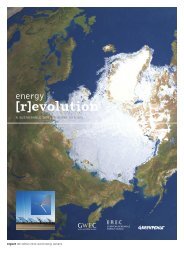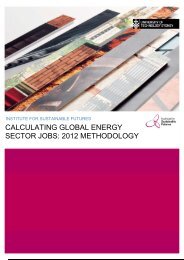download the mexico energy revolution scenario
download the mexico energy revolution scenario
download the mexico energy revolution scenario
You also want an ePaper? Increase the reach of your titles
YUMPU automatically turns print PDFs into web optimized ePapers that Google loves.
image CONSTRUCTION OF THE OFFSHORE<br />
WINDFARM AT MIDDELGRUNDEN NEAR<br />
COPENHAGEN, DENMARK.<br />
© PAUL LANGROCK/ZENIT/GP<br />
table 0.1: <strong>energy</strong> [r]evolution: summary for policy makers<br />
emissions transport consumer<br />
final <strong>energy</strong> heating power mechanisms targets targets<br />
POLICY<br />
Climate<br />
• Peak global temperature rise well below 2°C<br />
• Reduce ghg emissions by 40% by 2020 (as compared to 1990) in developed countries<br />
• Reduce ghg emissions by 15 to 30% of projected growth by 2020 in developing countries<br />
• Achieve zero deforestation globally by 2020<br />
• Agree a legally binding global climate deal as soon as possible<br />
Energy<br />
• USA: binding target of at least 20% renewable <strong>energy</strong> in primary <strong>energy</strong> consumption by 2020<br />
• G8: min 20% renewable <strong>energy</strong> by 2020<br />
• No new construction permits for new coal power plants in Annex 1 countries by 2012<br />
• Priority access to <strong>the</strong> grid for renewables<br />
• Establish efficiency targets and strict standards for electric applications<br />
• Strict efficiency target for vehicles: 80g CO2/km by 2020<br />
• Build regulations with mandatory renewable <strong>energy</strong> shares (e.g. solar collectors)<br />
• Co-generation law for industry and district heating support program<br />
Finance<br />
• Phase-out subsidies for fossil and nuclear fuels<br />
• Put in place a Climate Fund under <strong>the</strong> auspices of <strong>the</strong> UNFCCC<br />
• Provide at least 140 billion USD/year to <strong>the</strong> Climate Fund by 2020<br />
• Ensure priority access to <strong>the</strong> fund for vulnerable countries and communities<br />
• Establish feed-in law for renewable power generation in Annex 1 countries<br />
• Establish feed-in law with funding from Annex 1 countries for dev. countries<br />
ENERGY [R]EVOLUTION RESULTS<br />
Renewables & Supply<br />
Global Renewable Power Generation<br />
• Shares (max = adv. ER - Min = ER): 30% / 50% / 75% / over 90%<br />
• Implementation of Smart Grids (Policy/Planning/Construction)<br />
• Smart Grids interconnection to Super Grids (Policy/Planning/Construction)<br />
• Renewables cost competitive (max = worst case - min = best case)<br />
• Phase out of coal power plants in OECD countries<br />
• Phase out of nuclear power plants in OECD countries<br />
Global Renewable Heat supply shares<br />
• Shares (max = adv. ER - Min = ER): 30% / 50% / 75% / over 90%<br />
• Implementation of district heating (Policy/Planning/Construction)<br />
• Renewables cost competive (max = worst case - min = best case)<br />
Global Renewable Final Energy shares<br />
• Shares (max = adv. ER - Min = ER): 30% / 50% / 75% / over 90%<br />
• Consumer and business (O<strong>the</strong>r Sectors)<br />
• Industry<br />
• Transport<br />
• Total Final Energy<br />
Efficiency & Demand<br />
Global Statonary Energy Use<br />
• Efficiency standards reduce OECD household demand to 550 kWh/a per person<br />
• Power demand for IT equipment stablized and start to decrease<br />
• National <strong>energy</strong> intensity drops to 3 MJ/$GDP (Japan’s level today)<br />
Global Transport Development<br />
• Shift fright from road to rail and where possible from aviation to ships<br />
• Shift towards more public transport<br />
• Efficient cars become mainstream<br />
WHO 2010 2015 2020 2025 2030 2035 2040 2045 2050<br />
UNFCCC<br />
UNFCCC<br />
UNFCCC<br />
UNFCCC<br />
UNFCCC<br />
USA<br />
G8<br />
G8<br />
G8<br />
National Governments<br />
National Governments<br />
National Governments<br />
National Governments<br />
G20<br />
UNFCCC<br />
UNFCCC<br />
UNFCCC<br />
National Governments<br />
G8 + G77<br />
Utilities & RE Industry<br />
National Governments<br />
Gov & Grid Operator<br />
RE - Industry<br />
Utilities<br />
Utilities<br />
RE Industry<br />
National Governments<br />
RE Industry<br />
Cusumer Product Dev.<br />
IT Industry<br />
Industry + Gov.<br />
Gov. + Logistic Industry<br />
Regional Governments<br />
Car-Industry<br />
Energy Related CO2 Emissions<br />
• Global CO2 reductions (min = adv. ER - Max = ER): Emission peak / -30% / -50% / -80%<br />
• Annex 1 CO2 reductions (min = adv. ER - Max = ER): Emission peak / -30% / -50% / -80%<br />
• Non Annex 1 CO2 reductions (min = adv. ER - Max = ER): Emission peak / -30% / -50% / -80%<br />
13



![Energy [R]evolution - European Commission](https://img.yumpu.com/49109324/1/184x260/energy-revolution-european-commission.jpg?quality=85)


![5905 gp [eu rev]csfr4.qxd - Energy [R]evolution](https://img.yumpu.com/42305023/1/184x260/5905-gp-eu-revcsfr4qxd-energy-revolution.jpg?quality=85)


![5905 gp [eu rev]csfr4.qxd - Energy [R]evolution](https://img.yumpu.com/28729264/1/184x260/5905-gp-eu-revcsfr4qxd-energy-revolution.jpg?quality=85)